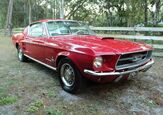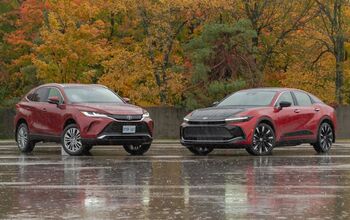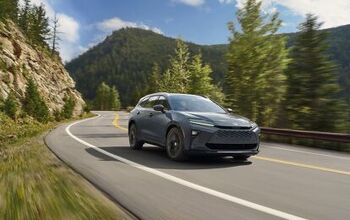Sibling Rivalry: Toyota Crown Signia vs Toyota Venza

And then there were two.
Toyota has no fewer than 10 SUVs available right now. That includes not one but two slightly larger two-row options in the shape of the existing Venza and the brand-new Crown Signia. This won’t be the case for long, as the Japanese brand has already confirmed the former will quietly bow out at the end of the year.
Before that happens, we got both of these hybrid SUVs together for a quick comparison. Is the new hotness the only right choice? Is there a good deal to be had on the short-lived, second-generation Venza?
These questions and more, answered.
Exterior Style
Crown Signia: The newer option trades on the design language seen on the latest Prius. The Crown Signia is one handsome rig, the “Hammerhead” front-end aligning with modern slim-light trends while also being immediately identifiable as new-Toyota. The melty-grille look of the bumper may not be to everyone’s tastes, however—and it’s more noticeable here without a front plate.
The sharp edges rising up and over the front wheels give the Signia a strong stance while suggesting it’s more aerodynamic than the Venza. It should be: the Signia sits noticeably lower which, combined with the added length, gives it a distinctly wagon vibe compared to the upright Venza.
Venza: Ever since it arrived on our shores in late 2020, the Venza has stood out from the rest of the Toyota lineup. Okay, maybe the nose has a bit of an Avalon vibe—or curse, given its discontinuation—but the filled-in grille and twin plinths of chrome do succeed in giving the Venza a premium look.
Move around to the sides and the strong shoulder line starts at the front door handles, creating a lip just above the (full-width) taillights where many lines meet, giving a sense of movement. The sharp rake to the rear glass helps, though it suggests the Venza prioritizes style over load-lugging ability. If only the 19-inch alloys were a more interesting design.
Interior Style and Quality
Crown Signia: Inside, the vehicle with only “Crown” on its tail looks just as you’d expect: like a Crown. The dashboard design is clean and simple, and this Limited tester comes in a tasteful brown-and-black combo. The center console is taller, giving more of a cockpit feel. Meanwhile, the electronic shifter is smaller, allowing for a gaggle of small buttons to surround it. Similarly, Toyota employs two rows of physical buttons just below the central touchscreen for easy climate controls. It’s a suitably swanky space, bridging the gap between the rest of Toyota’s SUV lineup and Lexus.
You might think the Crown’s larger footprint would lead to more passenger space, but… nope, not really. Headroom is slightly less up front (37.7 inches / 958 millimeters) on account of that lower roofline. Shoulder and hip room both are better in the older car too, typically by an inch or so; legroom is better up front but worse out back (37.1 inches / 942 mm). The boxier shape and lack of trick glass roof does give the Signia the rear headroom advantage by over two inches, at 39.1 inches (993 mm)—better than any other row in either vehicle.
Venza: The Venza’s odd-ball status within the vast Toyota empire extends to the cabin. There’s a hint of RAV4 in the vestigial V-shaped metallic spars front and center, but everything else is different. There’s more soft-touch material everywhere, including that pared-down center console, which is a refreshing change if not the most practical. Remember when Toyota shifters still resembled shifters? The Venza remembers.
We don’t love the touch controls for the climate, nor the buttons for audio volume—the one true approach is a dial, folks.
As mentioned above, the Venza doesn’t give away space to its newer sibling. The extra height affords the veteran an advantage in most measures, the only (big) disadvantage being the 36.9 in (937 mm) of rear headroom. Beyond that, the Venza’s seating position is perfectly comfortable and easy to adjust, and the power-adjustable steering wheel is a Lexus-level nicety.
Powertrain, Drivability, and Fuel Economy
Crown Signia: Both of these vehicles pack Toyota’s 2.5-liter inline-four engine and a pair of electric motors for e-AWD; there is no physical connection between the axles. The Crown runs a newer iteration with slightly more combined system horsepower (240 hp), largely due to a more powerful front electric motor. The Signia has to haul around an extra 300 pounds (136 kilograms) though, so real-world pace is practically a wash in this sibling rivalry. Toyota’s hybrid setup is responsive, and the newer model does a good job keeping the typical drone to a minimum, only really being an issue on full-throttle merging maneuvers.
Because of its lower center of gravity and increased wheelbase, the Signia has a more tied-down, mature ride. The huge 21-inch wheel and tire combo does add an extra bit of harshness over potholes, but largely, the Signia is a big smoothie. Selecting the Sport drive mode perks up the throttle response, and the light steering is pleasantly accurate, but this isn’t the sort of vehicle to fling at a series of hairpins. Ease off, and watch the miles melt away—as I did between Toronto and Montreal.
The EPA rates the Crown Signia at 39 mpg city, 37 mpg highway, and 38 mpg combined. Meanwhile, NRCAN says 6.0, 6.4, and 6.2 L/100 km, respectively, for the Canadian readers.
Venza: The Venza’s powerplant arrives wholesale from the RAV4. It’s very effective, but it does get buzzy in a way the newer model avoids. A system peak of 219 horsepower is plenty for daily use.
The RAV4 comparison extends to the drive feel, at least compared to the grown-up Signia. The Venza isn’t a bad drive, with good sound insulation and a comfort-oriented ride quality, but it feels stodgy and a little disconnected. It does handle pot holes and broken pavement with less audible disagreement than the Signia. Anybody buying either of these will have to take the extra cost of the Signia’s massive wheel/tire combo into consideration, too.
Both vehicles have the same 54-horsepower rear motor that, at least in hot early-summer weather, only really makes itself known on spirited take-offs. Otherwise these are basically front-drive vehicles.
Venza’s fuel economy is just a bit better than the Crown: its 40 mpg (5.9 L/100 km) city rating bumps its combined score to 39 mpg (6.1 L/100 km), while the highway rating remains 37 mpg (6.4 L/100 km).
Cargo and Towing
Crown Signia: Another surprise: the Signia’s boxy shape doesn’t give it the cargo-carrying crown. Not with all the seats up anyway: the Limited’s 24.8 cubic feet (702 liters) is almost 20-percent smaller than what Venza offers. Fold the seats down and the advantage swings the other way for the new kid, with a useful 66.1 cu ft (1,872 L). What’s more, the Venza has an extendable shelf to provide a load floor right to the front seat backs, or over six feet long from the lip.
Towing capacity is 2,700 lb (1,225 kg).
Venza: Venza’s got 28.7 cu ft (813 L) to play with, but that doesn’t even double to 54.9 cu ft (1,555 L) when running in two-seat form. Toyota doesn’t officially rate it for towing, either.
Note that both of these vehicles can have fractionally more cargo space in their lower trims.
Tech and Safety
Crown Signia: Both of these vehicles run the same 12.3-inch infotainment screen, so the following applies across the board. Generally it’s pretty smooth with quick responses, sharp graphics, and standard wireless Apple CarPlay and Android Auto. There needs to be a quicker way to swap between the native setup and the smartphone ones, however. The Signia also has a slight advantage by having an actual volume dial instead of buttons.
The Signia’s other advantages include the smarter wireless charger situation digital key function, and a slightly better, 11-speaker JBL system. Its glass roof is big but not as fancy. Why it lacks a head-up display is beyond us, too.
Toyota Safety Sense 3.0 brings just about every modern driver assist as standard. They all work well, though we still find Toyota’s Proactive Driving Assist overbearing, and the front cross-traffic alert is a cacophony at busy intersections.
Venza: Touch-sensitive climate controls. Ew.
Beyond those, the Venza’s most recent refresh means it has basically everything its sibling does. Digital instrument cluster? Check. Big touchscreen with the included 360-degree camera, including the clever “see-through” function? Check. The Venza sacrifices a few speakers in the JBL corral, but that’s fine. The head-up display is a welcome advantage, and we still love the trick, electrochromatic glass roof panels.
The TSS suite is a slightly older one at 2.5+, but that mostly boils down to PDA’s absence, which we’re okay with.
Value, Dollars, and Sense
Crown Signia: In America, the Crown Signia XLE starts at $44,985 including destination. The Limited you see here goes for $51,675, on account of the premium paint ($425) and Advanced Tech Package ($1,865).
In Canada, it’s the Limited only, with ($61,455 CAD) or without ($59,380 CAD) the tech package.
Venza: Since the Venza trim walk starts much lower at an LE, it has a significant price advantage. The starting point is $36,465 in America, before skipping through the XLE and Nightshade to land on the Limited ($44,610). Add the premium paint and this one is $45,035 out the door.
In Canada, the Venza LE lists for $44480 CAD including destination, while the Limited here lists for $54,180 CAD. Add the $255 CAD premium paint and the bottom line is $54,435 CAD.
Final Thoughts: Toyota Crown Signia vs Toyota Venza
For about a year after it launched, the Venza was a better Lexus NX than the actual NX. That model has since seen its own new model arrive—ushering in the current Toyota/Lexus infotainment system—and is nicer to drive, with more powertrain options including a plug-in hybrid. The Venza is starting to feel its age, and doesn’t have the footprint to match up to the rest of the larger two-row SUVs out there, even if that doesn’t necessarily mean a smaller cabin than the Signia. If you value the oddball pick, the Venza and its fancy frosted roof remains a practical option.
The Signia takes that mission statement—a Lexus in all but price—and runs with it. Essentially, in this sibling rivalry, the Crown Signia is around 10–15 percent richer, like-for-like. Whether the nicer cabin, better driving manners, and improved cargo-hauling capability is worth it is up to you.
Become an AutoGuide insider. Get the latest from the automotive world first by subscribing to our newsletter here.

Kyle began his automotive obsession before he even started school, courtesy of a remote control Porsche and various LEGO sets. He later studied advertising and graphic design at Humber College, which led him to writing about cars (both real and digital). He is now a proud member of the Automobile Journalists Association of Canada (AJAC), where he was the Journalist of the Year runner-up for 2021.
More by Kyle Patrick













































Comments
Join the conversation
Have you tried applying for a loan with Global Dominion?
Great article, thanks for the deep dive on both models. I agree that it is odd that there's no HUD or opaque roof option with the CS Limited Tech, esp considering it is $5k USD more (vs. '24 Venza Limited) for CS Limited trim with Tech. Maybe the '26 will add these. My wife has a '24 Venza Limited, it is a great ride with very cool Lexus tech. I am shopping the CS myself right now.